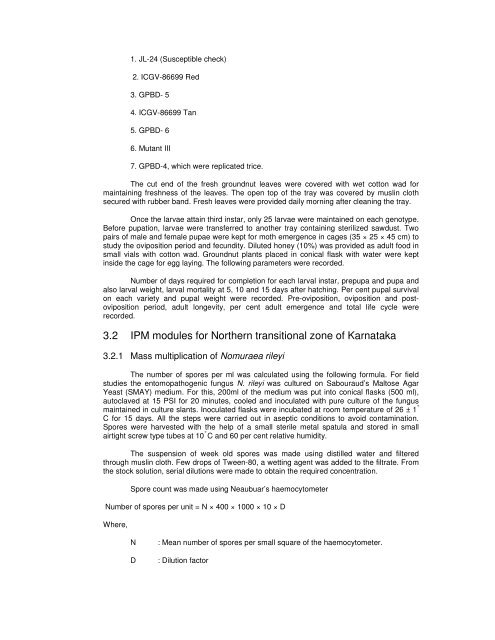screening elite genotypes and ipm of defoliators in groundnut
screening elite genotypes and ipm of defoliators in groundnut
screening elite genotypes and ipm of defoliators in groundnut
Create successful ePaper yourself
Turn your PDF publications into a flip-book with our unique Google optimized e-Paper software.
1. JL-24 (Susceptible check)<br />
2. ICGV-86699 Red<br />
3. GPBD- 5<br />
4. ICGV-86699 Tan<br />
5. GPBD- 6<br />
6. Mutant III<br />
7. GPBD-4, which were replicated trice.<br />
The cut end <strong>of</strong> the fresh <strong>groundnut</strong> leaves were covered with wet cotton wad for<br />
ma<strong>in</strong>ta<strong>in</strong><strong>in</strong>g freshness <strong>of</strong> the leaves. The open top <strong>of</strong> the tray was covered by musl<strong>in</strong> cloth<br />
secured with rubber b<strong>and</strong>. Fresh leaves were provided daily morn<strong>in</strong>g after clean<strong>in</strong>g the tray.<br />
Once the larvae atta<strong>in</strong> third <strong>in</strong>star, only 25 larvae were ma<strong>in</strong>ta<strong>in</strong>ed on each genotype.<br />
Before pupation, larvae were transferred to another tray conta<strong>in</strong><strong>in</strong>g sterilized sawdust. Two<br />
pairs <strong>of</strong> male <strong>and</strong> female pupae were kept for moth emergence <strong>in</strong> cages (35 × 25 × 45 cm) to<br />
study the oviposition period <strong>and</strong> fecundity. Diluted honey (10%) was provided as adult food <strong>in</strong><br />
small vials with cotton wad. Groundnut plants placed <strong>in</strong> conical flask with water were kept<br />
<strong>in</strong>side the cage for egg lay<strong>in</strong>g. The follow<strong>in</strong>g parameters were recorded.<br />
Number <strong>of</strong> days required for completion for each larval <strong>in</strong>star, prepupa <strong>and</strong> pupa <strong>and</strong><br />
also larval weight, larval mortality at 5, 10 <strong>and</strong> 15 days after hatch<strong>in</strong>g. Per cent pupal survival<br />
on each variety <strong>and</strong> pupal weight were recorded. Pre-oviposition, oviposition <strong>and</strong> post-<br />
oviposition period, adult longevity, per cent adult emergence <strong>and</strong> total life cycle were<br />
recorded.<br />
3.2 IPM modules for Northern transitional zone <strong>of</strong> Karnataka<br />
3.2.1 Mass multiplication <strong>of</strong> Nomuraea rileyi<br />
The number <strong>of</strong> spores per ml was calculated us<strong>in</strong>g the follow<strong>in</strong>g formula. For field<br />
studies the entomopathogenic fungus N. rileyi was cultured on Sabouraud’s Maltose Agar<br />
Yeast (SMAY) medium. For this, 200ml <strong>of</strong> the medium was put <strong>in</strong>to conical flasks (500 ml),<br />
autoclaved at 15 PSI for 20 m<strong>in</strong>utes, cooled <strong>and</strong> <strong>in</strong>oculated with pure culture <strong>of</strong> the fungus<br />
ma<strong>in</strong>ta<strong>in</strong>ed <strong>in</strong> culture slants. Inoculated flasks were <strong>in</strong>cubated at room temperature <strong>of</strong> 26 ± 1 °<br />
C for 15 days. All the steps were carried out <strong>in</strong> aseptic conditions to avoid contam<strong>in</strong>ation.<br />
Spores were harvested with the help <strong>of</strong> a small sterile metal spatula <strong>and</strong> stored <strong>in</strong> small<br />
airtight screw type tubes at 10 ° C <strong>and</strong> 60 per cent relative humidity.<br />
The suspension <strong>of</strong> week old spores was made us<strong>in</strong>g distilled water <strong>and</strong> filtered<br />
through musl<strong>in</strong> cloth. Few drops <strong>of</strong> Tween-80, a wett<strong>in</strong>g agent was added to the filtrate. From<br />
the stock solution, serial dilutions were made to obta<strong>in</strong> the required concentration.<br />
Spore count was made us<strong>in</strong>g Neaubuar’s haemocytometer<br />
Number <strong>of</strong> spores per unit = N × 400 × 1000 × 10 × D<br />
Where,<br />
N : Mean number <strong>of</strong> spores per small square <strong>of</strong> the haemocytometer.<br />
D : Dilution factor
















